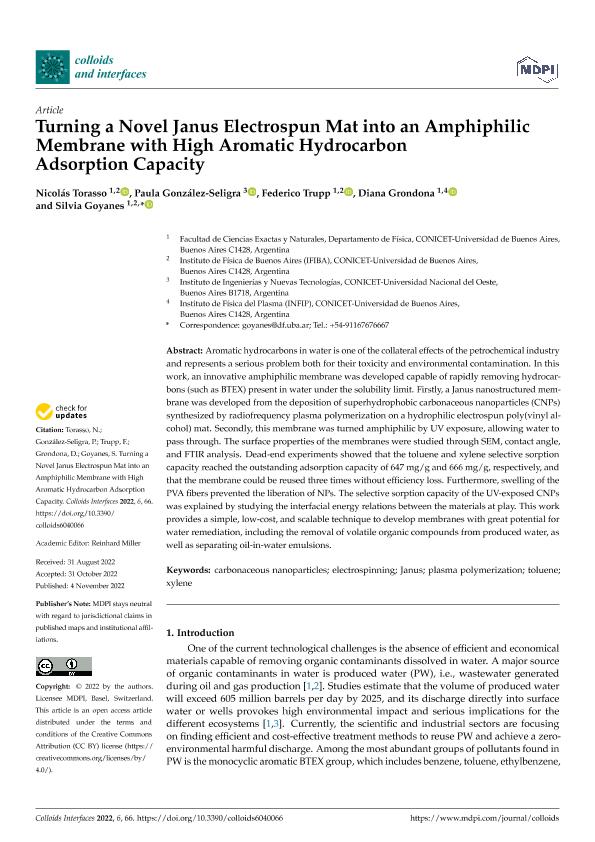Artículo
Turning a Novel Janus Electrospun Mat into an Amphiphilic Membrane with High Aromatic Hydrocarbon Adsorption Capacity
Torasso, Nicolás; González Seligra, Paula Fabiana ; Trupp, Federico Javier
; Trupp, Federico Javier ; Grondona, Diana Elena
; Grondona, Diana Elena ; Goyanes, Silvia Nair
; Goyanes, Silvia Nair
 ; Trupp, Federico Javier
; Trupp, Federico Javier ; Grondona, Diana Elena
; Grondona, Diana Elena ; Goyanes, Silvia Nair
; Goyanes, Silvia Nair
Fecha de publicación:
12/2022
Editorial:
Multidisciplinary Digital Publishing Institute
Revista:
Colloids and Interfaces
ISSN:
2504-5377
Idioma:
Inglés
Tipo de recurso:
Artículo publicado
Clasificación temática:
Resumen
Aromatic hydrocarbons in water is one of the collateral effects of the petrochemical industry and represents a serious problem both for their toxicity and environmental contamination. In this work, an innovative amphiphilic membrane was developed capable of rapidly removing hydrocarbons (such as BTEX) present in water under the solubility limit. Firstly, a Janus nanostructured membrane was developed from the deposition of superhydrophobic carbonaceous nanoparticles (CNPs) synthesized by radiofrequency plasma polymerization on a hydrophilic electrospun poly(vinyl alcohol) mat. Secondly, this membrane was turned amphiphilic by UV exposure, allowing water to pass through. The surface properties of the membranes were studied through SEM, contact angle, and FTIR analysis. Dead-end experiments showed that the toluene and xylene selective sorption capacity reached the outstanding adsorption capacity of 647 mg/g and 666 mg/g, respectively, and that the membrane could be reused three times without efficiency loss. Furthermore, swelling of the PVA fibers prevented the liberation of NPs. The selective sorption capacity of the UV-exposed CNPs was explained by studying the interfacial energy relations between the materials at play. This work provides a simple, low-cost, and scalable technique to develop membranes with great potential for water remediation, including the removal of volatile organic compounds from produced water, as well as separating oil-in-water emulsions.
Archivos asociados
Licencia
Identificadores
Colecciones
Articulos(INFINA)
Articulos de INST.DE FISICA DEL PLASMA
Articulos de INST.DE FISICA DEL PLASMA
Articulos(SEDE CENTRAL)
Articulos de SEDE CENTRAL
Articulos de SEDE CENTRAL
Citación
Torasso, Nicolás; González Seligra, Paula Fabiana; Trupp, Federico Javier; Grondona, Diana Elena; Goyanes, Silvia Nair; Turning a Novel Janus Electrospun Mat into an Amphiphilic Membrane with High Aromatic Hydrocarbon Adsorption Capacity; Multidisciplinary Digital Publishing Institute; Colloids and Interfaces; 6; 4; 12-2022; 1-13
Compartir
Altmétricas



